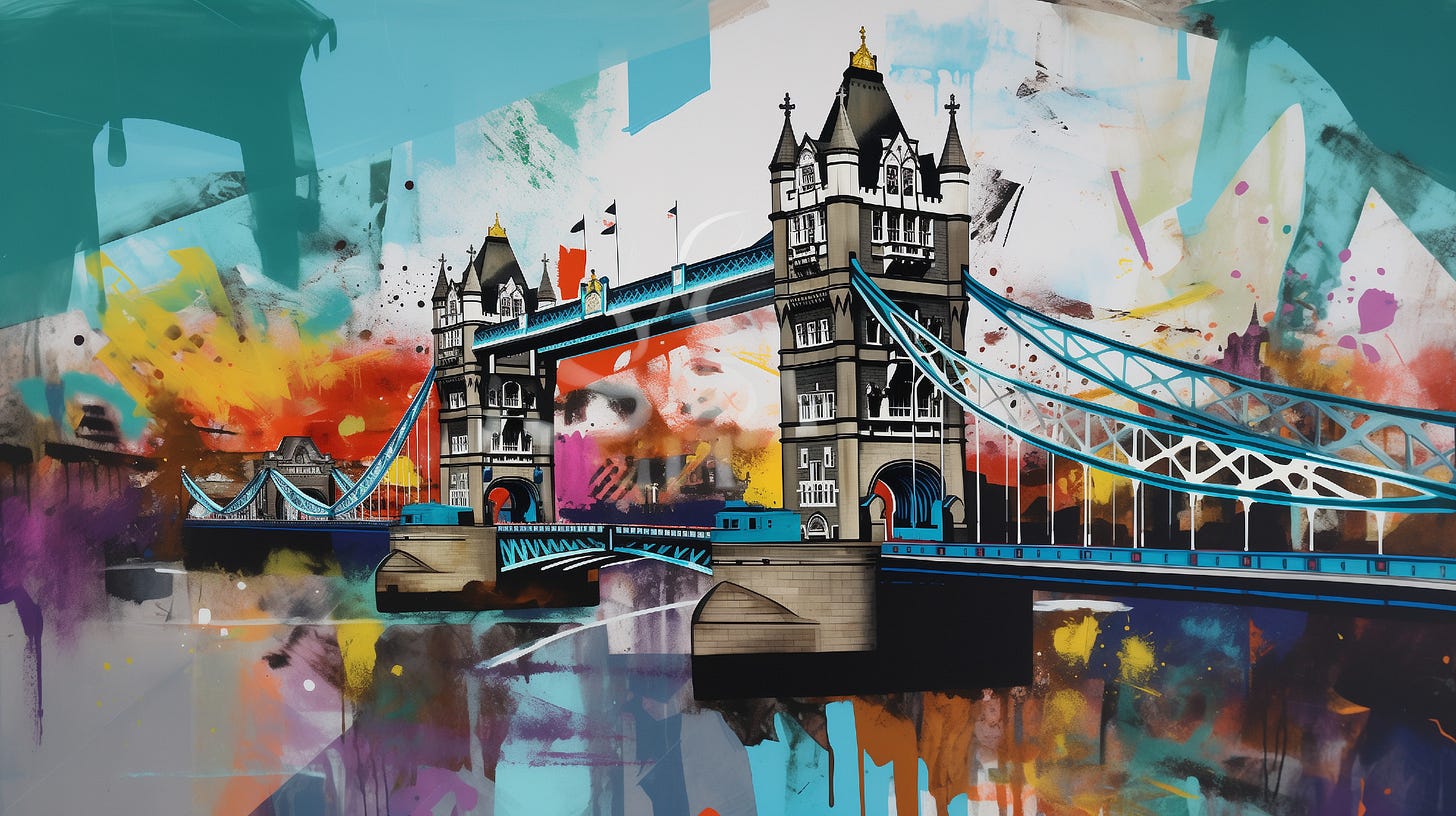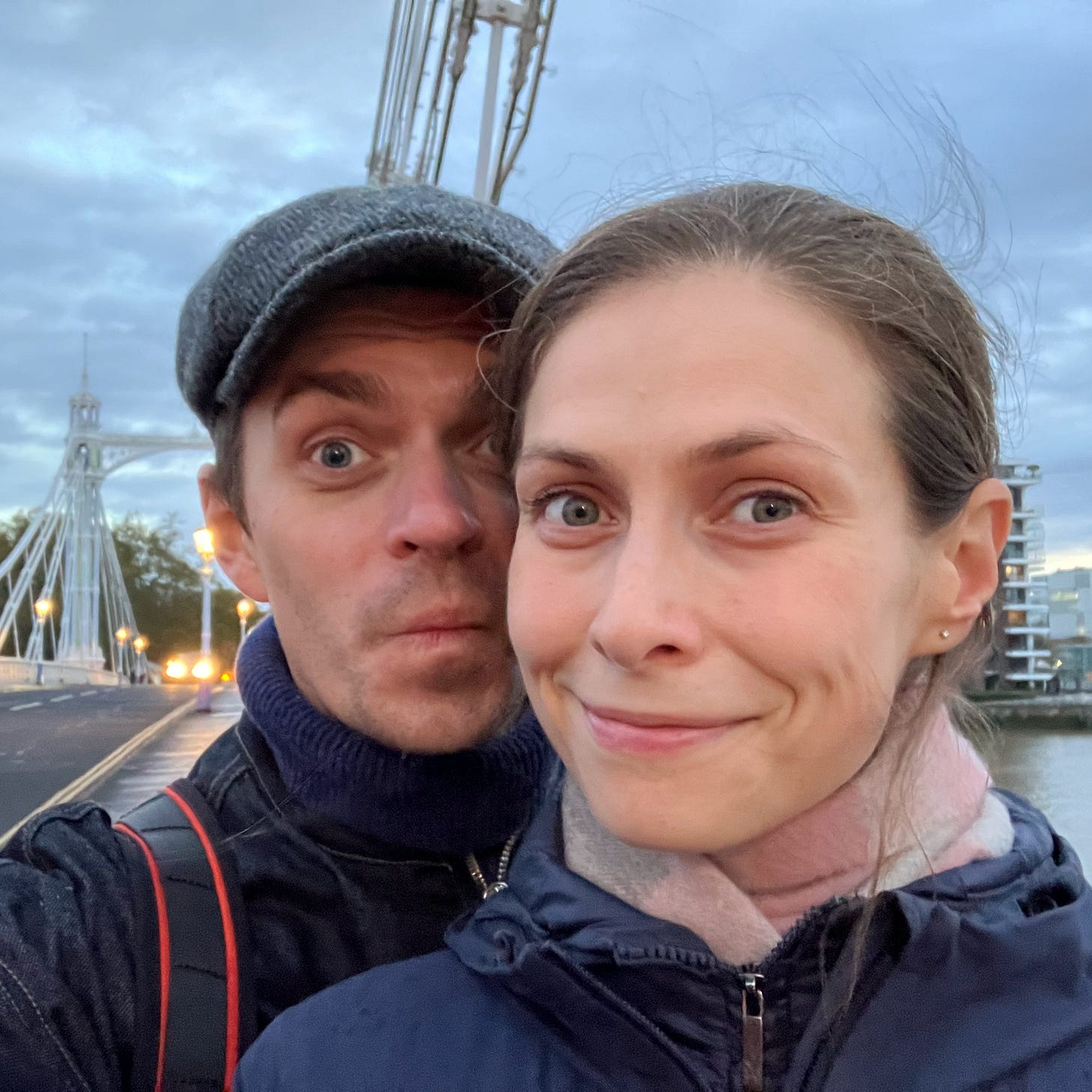🚶♂️ I walked across every Thames bridge in London. Here's what I learned
Hey, folks! Ever looked at a map of London and thought, “I should walk over every Thames bridge in order”? No? Just me, then.
Full disclosure: Just like my journey across London, this newsletter is long. Brace yourselves — and maybe stretch first.
Last year, I discovered that there are 28 pedestrian-accessible bridges across the Thames in London. Naturally, a plan formed: I had to walk across every single one.
As usual, I procrastinated until my lovely wife Anastasia got tired of my moaning and marched me out of the house to start conquering London’s bridges. The rules were simple: walk across every bridge from Hampton Court to Tower Bridge, taking a selfie on each. The journey between bridges had to be done entirely on foot: no buses, trains, taxis or bikes. By my estimate, it would be about 42 kilometres. Spoiler alert: I massively underestimated the scale of the ordeal.
The original idea was to do it all in one day. That dream collapsed under three harsh truths: the Thames meanders, London is enormous, and winter days, which is when we set out, are annoyingly short.
The trouble started between the first and second bridges. We arrived at Hampton Court, cheerfully crossed the bridge and headed for Kingston. Google Maps (damn you, Sergey Brin!) suggested a shortcut through a park, which turned out to be closed. We detoured six kilometres before the expedition had even properly begun. By the time we reached Richmond, it was pitch dark and we’d clocked 24 kilometres in six hours.
Here’s what we managed to cross before night fell and our legs gave out:
Hampton Court Bridge, built with red-brick cladding over concrete, looks like something Sir Christopher Wren might have designed himself, had he lived until 1933. Naturally, it offers views of Hampton Court Palace — and a few swans for atmosphere.
Kingston Bridge, opened in 1828, replaced a long-standing wooden crossing. I rather like its elegant Portland stone arches.
Teddington Lock Footbridges are two linked pedestrian bridges zigzagging between riverbanks and an island. Apparently, this is where the Thames stops being tidal.
Richmond Bridge, completed in 1777, is London’s oldest surviving Thames bridge. Dare I say, it looks even older — like some Tudor relic — a beautiful bridge, with perfect proportions and timeless charm.
Four bridges down. Just a few to go. We made the executive decision to continue the following weekend.
That week, I suffered. Not because we’d paused at the most exciting bit, but because my legs were not designed for 24 kilometres a day. Ten? Easy. Fifteen? Lovely. Beyond that? I just want to lie down and die, which is more or less what I did.
By the following Saturday, I’d recovered, and we had picked up where we had left off. Attempt number two was easier. By evening, we’d made it to Battersea, ten bridges and about 25 kilometres behind us. Bridges from Richmond to Battersea were calmer and more scenic: fewer crowds and the quiet joy of just walking.
Twickenham Bridge is an Art Deco masterpiece with subtle bronze accents. It could also serve as a trick question in a pub quiz: thanks to a bend in the river, St Margarets (on the north bank) ends up on the southwest side of the bridge, while Richmond (on the south bank) is on the northeast. Mind-blowing.
Richmond Lock and Footbridge has green iron arches and a certain fairy-tale quality. More charming than expected for a structure designed to control the river’s tidal flow.
Kew Bridge features stone arches with a historical flair. Not the most impressive bridge, but it blends nicely with its surroundings. And if you want to be impressed, head to neighbouring Kew Gardens.
Chiswick Bridge is best known as the finish line of the Oxford–Cambridge Boat Race. There’s even a stone nearby marking the exact finish.
Barnes Bridge is a railway bridge with a pedestrian path tacked on. It has a certain industrial elegance, and while crossing it feels like trespassing, it’s completely legal (I hope).
Hammersmith Bridge, opened in 1887, is a cast-iron suspension bridge and, frankly, eye candy. This gem of Victorian engineering was designed by none other than Sir Joseph Bazalgette, the founding father of London’s sewer system and countless other infrastructure feats.
Putney Bridge, built in 1886, is another of Bazalgette’s creations. Fun fact: it’s the only bridge in London with churches at both ends. At this point in the walk, I was seriously considering praying for the pain to end. No such luck.
Fulham Railway Bridge carries District Line trains and has a pedestrian walkway bolted to the side. According to Wikipedia, it has no official name. Surely that can’t be right.
Wandsworth Bridge, a wartime build from 1940, was painted in shades of blue as camouflage during air raids. Function over form, I respect that.
Battersea Bridge, from 1890... Oh, who am I kidding? By this stage, I couldn’t care less about its history or structure. There was a bridge, we took a selfie, and went home.
The last stretch — from Battersea to Tower Bridge — happened a couple of weeks later. Fourteen bridges, roughly 15 kilometres. The final leg brought us back into the thick of the city with all of its postcard views.
Albert Bridge is a pastel confection of cables and caution signs, warning troops to break step when crossing. It is one of my favourite bridges to cross, especially when breaking a step.
Chelsea Bridge replaced a narrow and unreliable predecessor. The original was called Victoria Bridge — until fears of collapse prompted a quiet renaming to spare the monarchy any embarrassment.
Vauxhall Bridge features large statues representing the arts and sciences, though few people ever seem to notice.
Lambeth Bridge was painted red, taking its colour cue from the seats in the House of Lords. It’s quieter than its Westminster neighbour.
Westminster Bridge was painted green to match the seats — yes, you guessed it — in the House of Commons. It offers great views and is therefore packed with tourists. Crossing it on a busy weekend can be quite an ordeal.
The Golden Jubilee Footbridges were added in 2002 on either side of the Hungerford Railway Bridge. A bit clumsy for my taste, but a good spot for selfies. And yes, I crossed both — so that’s two bridges. My challenge, my rules.
Waterloo Bridge is a 1945 concrete arch bridge, built during WWII largely by women, hence the nickname “The Ladies’ Bridge.” Somehow, it makes reinforced concrete feel poetic.
Blackfriars Bridge features cast iron arches and Victorian details, with decent views of St Paul’s and the South Bank.
Blackfriars Railway Bridge hosts the only train station in London that spans the Thames. I love staring out the windows every time I pass — it’s part bridge, part viewing platform.
Millennium Bridge opened in 2000 as a futuristic pedestrian suspension bridge linking St Paul’s to the Tate Modern. Famously wobbly on day one, it’s since been fixed and landed a few starring roles in low-budget film productions.
Southwark Bridge is often overlooked in favour of its flashier neighbours. But after the bustle of Westminster and Millennium bridges, it offers a rather splendid walking experience.
London Bridge, in its current form since 1973, is a bridge with an identity crisis — functional and dull, like a well-organised spreadsheet.
Tower Bridge, completed in 1894, is a neo-Gothic marvel with a bascule mechanism that lifts to let ships through (a must-see attraction). It’s absurd, beautiful, and slightly ridiculous — perfect as the finish line for our trip.
Mission accomplished. No idea what to do with my life now.
Although actually, I do have a plan: next, I want to do all the bridges over a weekend. And then, someday, the whole thing in a single day.
So, what did this highly questionable exercise teach me?
First, my wife is the perfect adventure partner (though I knew that already). Second, West London has some genuinely lovely spots we South East London snobs wouldn’t normally visit. (Speaking of SE London, have you read my post about the Battle of Deptford Bridge?) Kingston is absolutely charming — and home to London’s oldest surviving bridge, nearly 800 years old. Third, some bridges are simply beautiful. My top five: Twickenham Bridge, Hammersmith Bridge, Albert Bridge, Waterloo Bridge, and, of course, Tower Bridge. Obviously.
That’s it for today! Thanks for reading! If you enjoy the newsletter, share it with a friend — or a dozen. And if you really enjoyed it, consider upgrading to a paid subscription: it helps support my work and means a lot.
Elia Kabanov is a science writer covering the past, present and future of technology (@metkere)
Illustration: Elia Kabanov feat. MidJourney.
PS For the purists: I counted the Golden Jubilee Bridges as two separate crossings. The total distance also includes the walk from home to the nearest station and back, plus a few intentional detours away from the river to explore unfamiliar neighbourhoods.
I decided not to include photos here to keep the newsletter compact (though let’s be honest, I clearly failed). I’ll post pictures on BlueSky and Twitter, so follow me there if you want to see all the bridges and a few increasingly tired selfies.




I love this challenge! Sounds like the sort of thing I'd try to do. Although I wouldn't try it in a day ...